Career Research in Supermarket Retailing Industry Report
VerifiedAdded on 2020/03/07
|19
|6933
|34
Report
AI Summary
This report provides a comprehensive analysis of career paths within the supermarket retailing industry, focusing on three key departments: Human Resource Management, Accounting and Finance, and Marketing and Sales. It explores specific job positions within each department, such as Training and Development in HR, Financial Analyst in Accounting, and Marketing Manager in Sales, detailing the nature of the work, required education, skills, salary expectations, and the labor market outlook. The report also examines the organizational structures, histories, and cultures of three major companies: Wesfarmers, Woolworths Limited, and JB HiFi, providing context for the career opportunities within these companies. Furthermore, the report discusses entry-level, middle-level, and upper-level positions, including qualifications and potential career progression within each department. The report concludes with reflections on the suitability of the researched career paths, emphasizing the importance of skills, experience, and personal attributes for success in the retail industry.
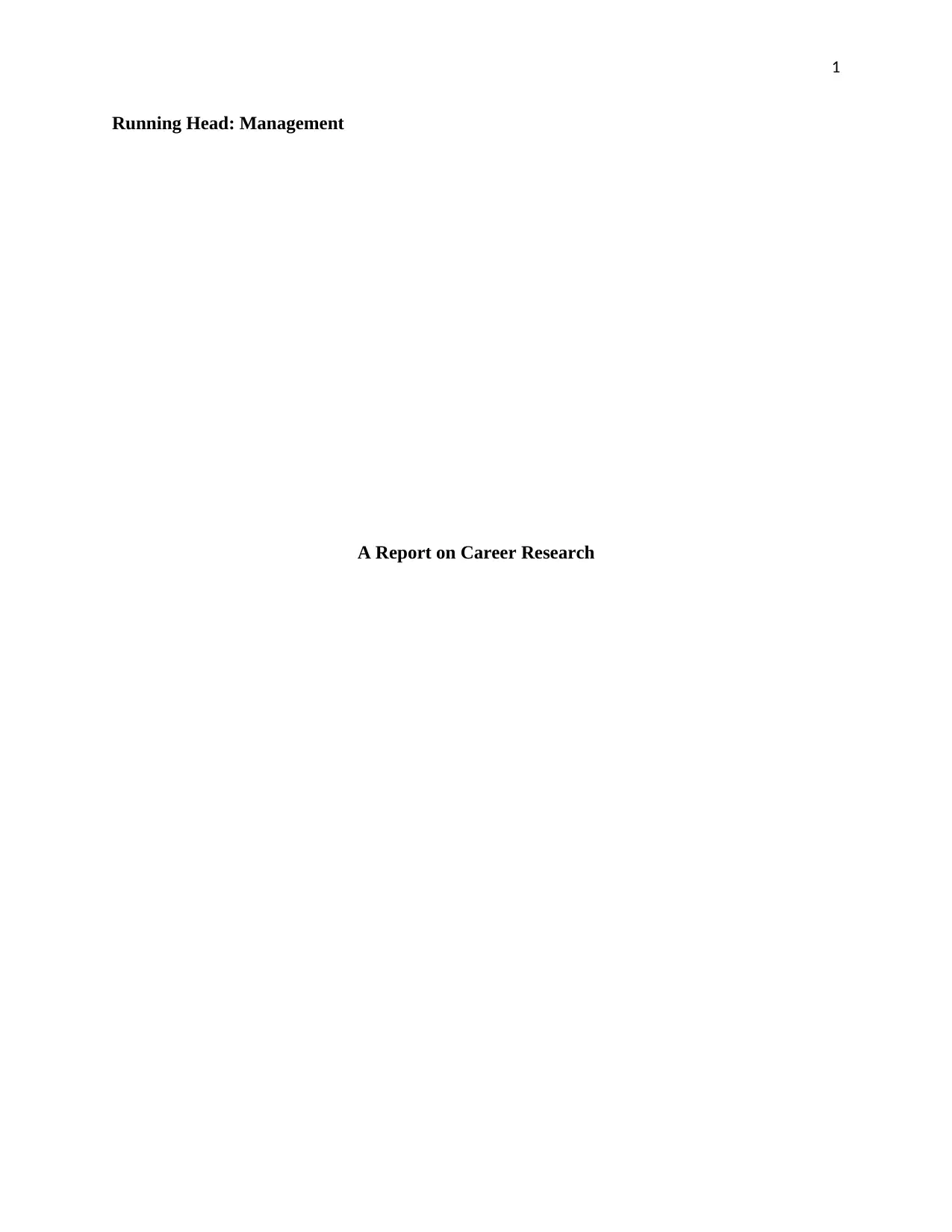
1
Running Head: Management
A Report on Career Research
Running Head: Management
A Report on Career Research
Paraphrase This Document
Need a fresh take? Get an instant paraphrase of this document with our AI Paraphraser
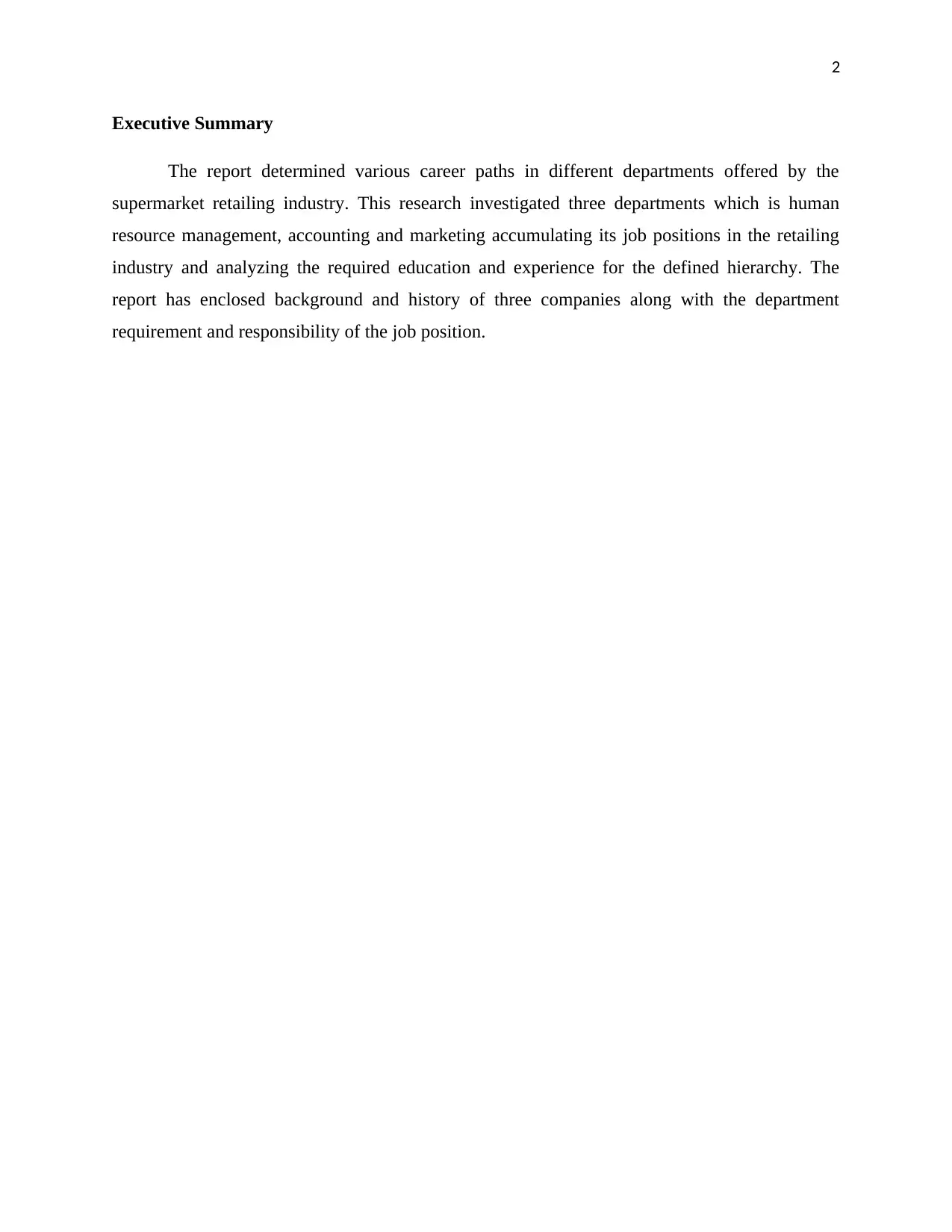
2
Executive Summary
The report determined various career paths in different departments offered by the
supermarket retailing industry. This research investigated three departments which is human
resource management, accounting and marketing accumulating its job positions in the retailing
industry and analyzing the required education and experience for the defined hierarchy. The
report has enclosed background and history of three companies along with the department
requirement and responsibility of the job position.
Executive Summary
The report determined various career paths in different departments offered by the
supermarket retailing industry. This research investigated three departments which is human
resource management, accounting and marketing accumulating its job positions in the retailing
industry and analyzing the required education and experience for the defined hierarchy. The
report has enclosed background and history of three companies along with the department
requirement and responsibility of the job position.
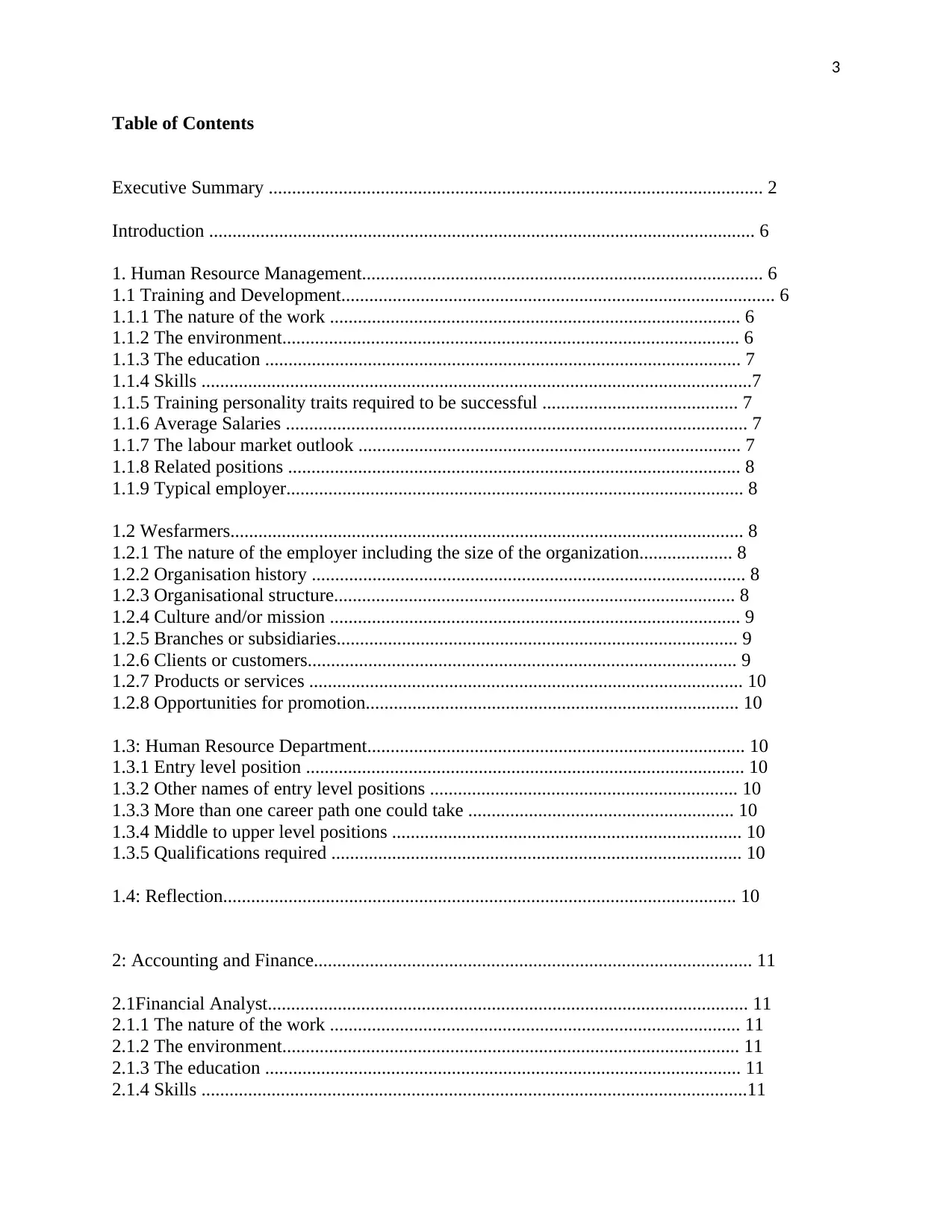
3
Table of Contents
Executive Summary .......................................................................................................... 2
Introduction ..................................................................................................................... 6
1. Human Resource Management...................................................................................... 6
1.1 Training and Development............................................................................................. 6
1.1.1 The nature of the work ........................................................................................ 6
1.1.2 The environment.................................................................................................. 6
1.1.3 The education ...................................................................................................... 7
1.1.4 Skills ......................................................................................................................7
1.1.5 Training personality traits required to be successful .......................................... 7
1.1.6 Average Salaries ................................................................................................... 7
1.1.7 The labour market outlook .................................................................................. 7
1.1.8 Related positions ................................................................................................. 8
1.1.9 Typical employer.................................................................................................. 8
1.2 Wesfarmers.............................................................................................................. 8
1.2.1 The nature of the employer including the size of the organization.................... 8
1.2.2 Organisation history ............................................................................................. 8
1.2.3 Organisational structure...................................................................................... 8
1.2.4 Culture and/or mission ........................................................................................ 9
1.2.5 Branches or subsidiaries...................................................................................... 9
1.2.6 Clients or customers............................................................................................ 9
1.2.7 Products or services ............................................................................................. 10
1.2.8 Opportunities for promotion................................................................................ 10
1.3: Human Resource Department................................................................................. 10
1.3.1 Entry level position .............................................................................................. 10
1.3.2 Other names of entry level positions .................................................................. 10
1.3.3 More than one career path one could take ......................................................... 10
1.3.4 Middle to upper level positions ........................................................................... 10
1.3.5 Qualifications required ........................................................................................ 10
1.4: Reflection.............................................................................................................. 10
2: Accounting and Finance.............................................................................................. 11
2.1Financial Analyst....................................................................................................... 11
2.1.1 The nature of the work ........................................................................................ 11
2.1.2 The environment.................................................................................................. 11
2.1.3 The education ...................................................................................................... 11
2.1.4 Skills .....................................................................................................................11
Table of Contents
Executive Summary .......................................................................................................... 2
Introduction ..................................................................................................................... 6
1. Human Resource Management...................................................................................... 6
1.1 Training and Development............................................................................................. 6
1.1.1 The nature of the work ........................................................................................ 6
1.1.2 The environment.................................................................................................. 6
1.1.3 The education ...................................................................................................... 7
1.1.4 Skills ......................................................................................................................7
1.1.5 Training personality traits required to be successful .......................................... 7
1.1.6 Average Salaries ................................................................................................... 7
1.1.7 The labour market outlook .................................................................................. 7
1.1.8 Related positions ................................................................................................. 8
1.1.9 Typical employer.................................................................................................. 8
1.2 Wesfarmers.............................................................................................................. 8
1.2.1 The nature of the employer including the size of the organization.................... 8
1.2.2 Organisation history ............................................................................................. 8
1.2.3 Organisational structure...................................................................................... 8
1.2.4 Culture and/or mission ........................................................................................ 9
1.2.5 Branches or subsidiaries...................................................................................... 9
1.2.6 Clients or customers............................................................................................ 9
1.2.7 Products or services ............................................................................................. 10
1.2.8 Opportunities for promotion................................................................................ 10
1.3: Human Resource Department................................................................................. 10
1.3.1 Entry level position .............................................................................................. 10
1.3.2 Other names of entry level positions .................................................................. 10
1.3.3 More than one career path one could take ......................................................... 10
1.3.4 Middle to upper level positions ........................................................................... 10
1.3.5 Qualifications required ........................................................................................ 10
1.4: Reflection.............................................................................................................. 10
2: Accounting and Finance.............................................................................................. 11
2.1Financial Analyst....................................................................................................... 11
2.1.1 The nature of the work ........................................................................................ 11
2.1.2 The environment.................................................................................................. 11
2.1.3 The education ...................................................................................................... 11
2.1.4 Skills .....................................................................................................................11
⊘ This is a preview!⊘
Do you want full access?
Subscribe today to unlock all pages.

Trusted by 1+ million students worldwide
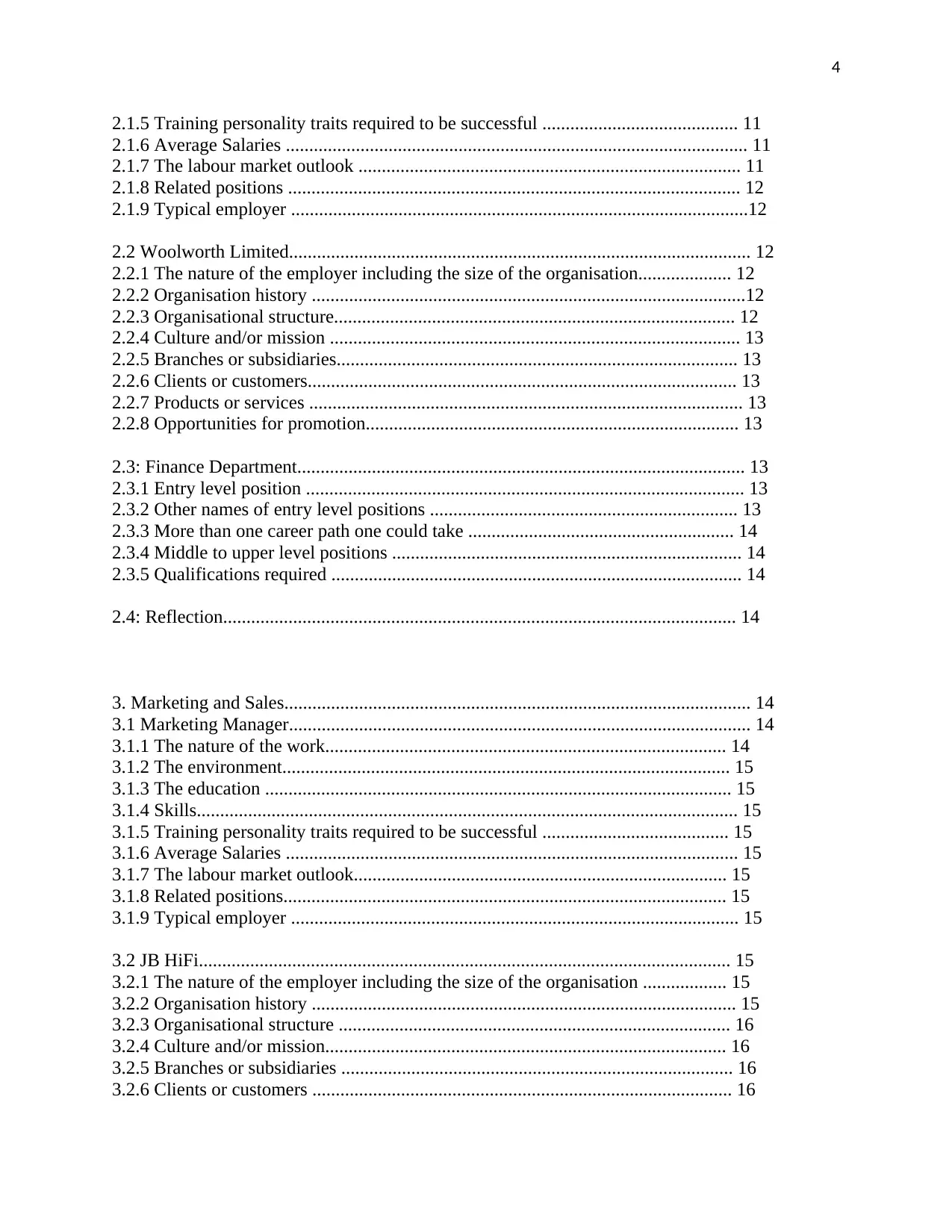
4
2.1.5 Training personality traits required to be successful .......................................... 11
2.1.6 Average Salaries ................................................................................................... 11
2.1.7 The labour market outlook .................................................................................. 11
2.1.8 Related positions ................................................................................................. 12
2.1.9 Typical employer ..................................................................................................12
2.2 Woolworth Limited................................................................................................... 12
2.2.1 The nature of the employer including the size of the organisation.................... 12
2.2.2 Organisation history .............................................................................................12
2.2.3 Organisational structure...................................................................................... 12
2.2.4 Culture and/or mission ........................................................................................ 13
2.2.5 Branches or subsidiaries...................................................................................... 13
2.2.6 Clients or customers............................................................................................ 13
2.2.7 Products or services ............................................................................................. 13
2.2.8 Opportunities for promotion................................................................................ 13
2.3: Finance Department................................................................................................ 13
2.3.1 Entry level position .............................................................................................. 13
2.3.2 Other names of entry level positions .................................................................. 13
2.3.3 More than one career path one could take ......................................................... 14
2.3.4 Middle to upper level positions ........................................................................... 14
2.3.5 Qualifications required ........................................................................................ 14
2.4: Reflection.............................................................................................................. 14
3. Marketing and Sales.................................................................................................... 14
3.1 Marketing Manager................................................................................................... 14
3.1.1 The nature of the work...................................................................................... 14
3.1.2 The environment................................................................................................ 15
3.1.3 The education .................................................................................................... 15
3.1.4 Skills.................................................................................................................... 15
3.1.5 Training personality traits required to be successful ........................................ 15
3.1.6 Average Salaries ................................................................................................. 15
3.1.7 The labour market outlook................................................................................ 15
3.1.8 Related positions............................................................................................... 15
3.1.9 Typical employer ................................................................................................ 15
3.2 JB HiFi.................................................................................................................. 15
3.2.1 The nature of the employer including the size of the organisation .................. 15
3.2.2 Organisation history ........................................................................................... 15
3.2.3 Organisational structure .................................................................................... 16
3.2.4 Culture and/or mission...................................................................................... 16
3.2.5 Branches or subsidiaries .................................................................................... 16
3.2.6 Clients or customers .......................................................................................... 16
2.1.5 Training personality traits required to be successful .......................................... 11
2.1.6 Average Salaries ................................................................................................... 11
2.1.7 The labour market outlook .................................................................................. 11
2.1.8 Related positions ................................................................................................. 12
2.1.9 Typical employer ..................................................................................................12
2.2 Woolworth Limited................................................................................................... 12
2.2.1 The nature of the employer including the size of the organisation.................... 12
2.2.2 Organisation history .............................................................................................12
2.2.3 Organisational structure...................................................................................... 12
2.2.4 Culture and/or mission ........................................................................................ 13
2.2.5 Branches or subsidiaries...................................................................................... 13
2.2.6 Clients or customers............................................................................................ 13
2.2.7 Products or services ............................................................................................. 13
2.2.8 Opportunities for promotion................................................................................ 13
2.3: Finance Department................................................................................................ 13
2.3.1 Entry level position .............................................................................................. 13
2.3.2 Other names of entry level positions .................................................................. 13
2.3.3 More than one career path one could take ......................................................... 14
2.3.4 Middle to upper level positions ........................................................................... 14
2.3.5 Qualifications required ........................................................................................ 14
2.4: Reflection.............................................................................................................. 14
3. Marketing and Sales.................................................................................................... 14
3.1 Marketing Manager................................................................................................... 14
3.1.1 The nature of the work...................................................................................... 14
3.1.2 The environment................................................................................................ 15
3.1.3 The education .................................................................................................... 15
3.1.4 Skills.................................................................................................................... 15
3.1.5 Training personality traits required to be successful ........................................ 15
3.1.6 Average Salaries ................................................................................................. 15
3.1.7 The labour market outlook................................................................................ 15
3.1.8 Related positions............................................................................................... 15
3.1.9 Typical employer ................................................................................................ 15
3.2 JB HiFi.................................................................................................................. 15
3.2.1 The nature of the employer including the size of the organisation .................. 15
3.2.2 Organisation history ........................................................................................... 15
3.2.3 Organisational structure .................................................................................... 16
3.2.4 Culture and/or mission...................................................................................... 16
3.2.5 Branches or subsidiaries .................................................................................... 16
3.2.6 Clients or customers .......................................................................................... 16
Paraphrase This Document
Need a fresh take? Get an instant paraphrase of this document with our AI Paraphraser
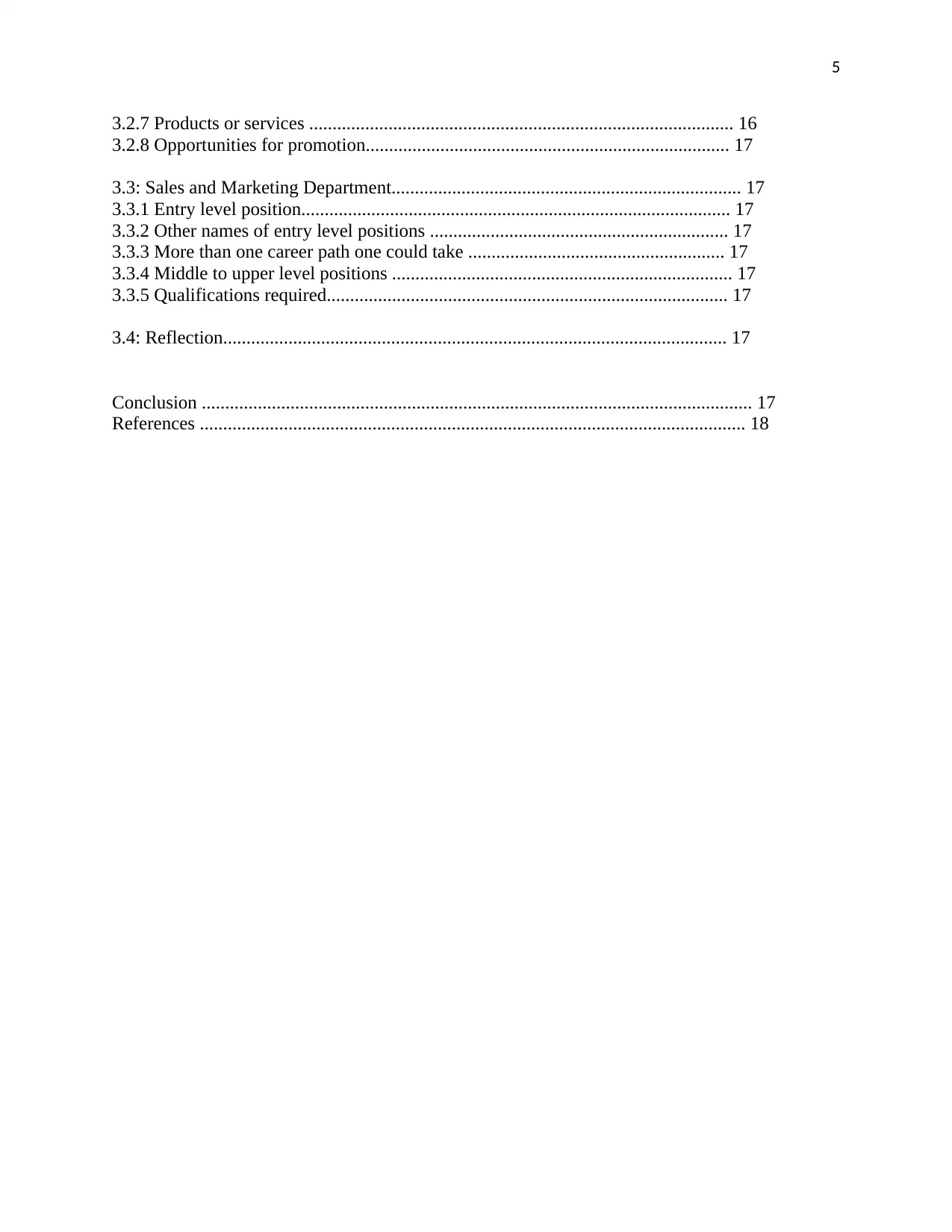
5
3.2.7 Products or services ........................................................................................... 16
3.2.8 Opportunities for promotion.............................................................................. 17
3.3: Sales and Marketing Department........................................................................... 17
3.3.1 Entry level position............................................................................................ 17
3.3.2 Other names of entry level positions ................................................................ 17
3.3.3 More than one career path one could take ....................................................... 17
3.3.4 Middle to upper level positions ......................................................................... 17
3.3.5 Qualifications required...................................................................................... 17
3.4: Reflection............................................................................................................ 17
Conclusion ...................................................................................................................... 17
References ..................................................................................................................... 18
3.2.7 Products or services ........................................................................................... 16
3.2.8 Opportunities for promotion.............................................................................. 17
3.3: Sales and Marketing Department........................................................................... 17
3.3.1 Entry level position............................................................................................ 17
3.3.2 Other names of entry level positions ................................................................ 17
3.3.3 More than one career path one could take ....................................................... 17
3.3.4 Middle to upper level positions ......................................................................... 17
3.3.5 Qualifications required...................................................................................... 17
3.4: Reflection............................................................................................................ 17
Conclusion ...................................................................................................................... 17
References ..................................................................................................................... 18
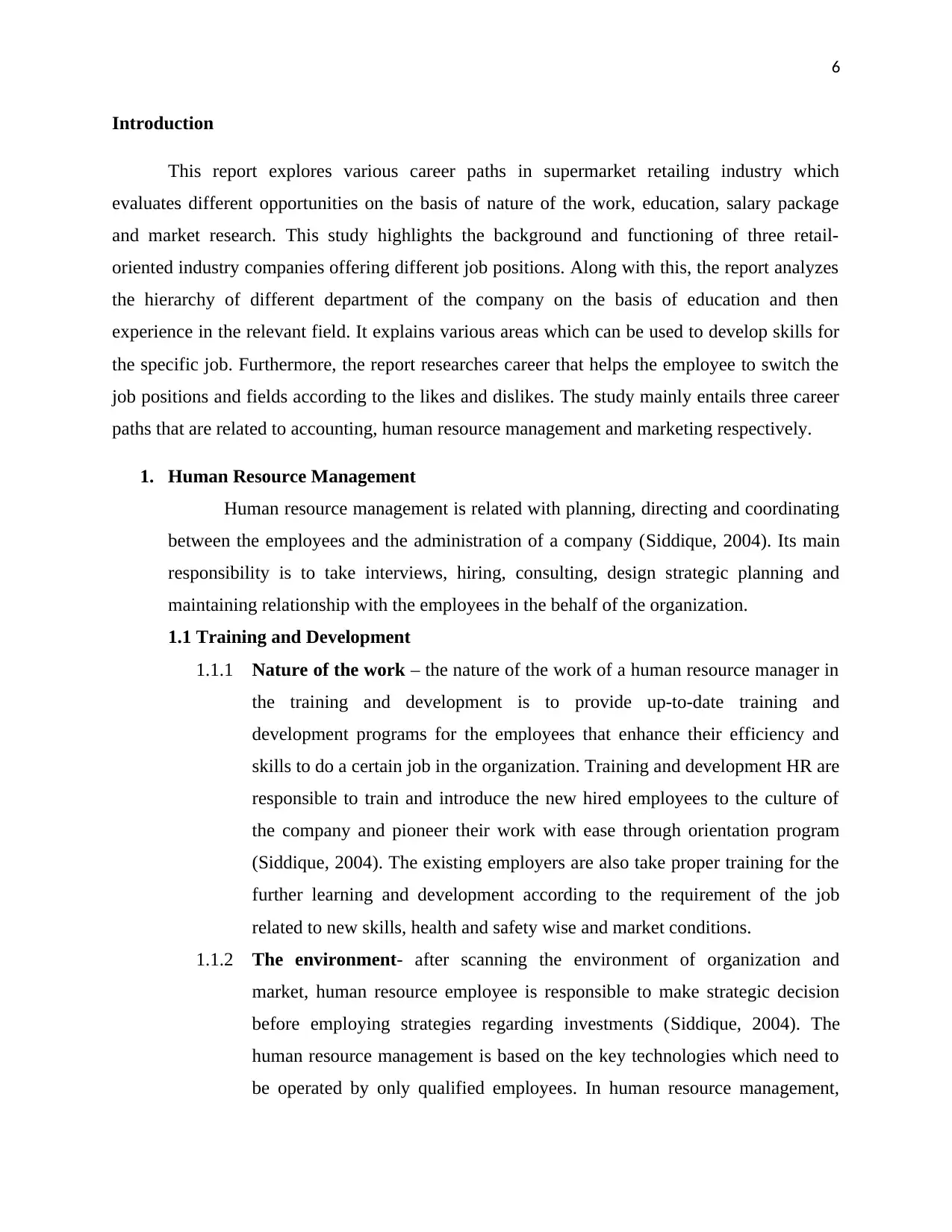
6
Introduction
This report explores various career paths in supermarket retailing industry which
evaluates different opportunities on the basis of nature of the work, education, salary package
and market research. This study highlights the background and functioning of three retail-
oriented industry companies offering different job positions. Along with this, the report analyzes
the hierarchy of different department of the company on the basis of education and then
experience in the relevant field. It explains various areas which can be used to develop skills for
the specific job. Furthermore, the report researches career that helps the employee to switch the
job positions and fields according to the likes and dislikes. The study mainly entails three career
paths that are related to accounting, human resource management and marketing respectively.
1. Human Resource Management
Human resource management is related with planning, directing and coordinating
between the employees and the administration of a company (Siddique, 2004). Its main
responsibility is to take interviews, hiring, consulting, design strategic planning and
maintaining relationship with the employees in the behalf of the organization.
1.1 Training and Development
1.1.1 Nature of the work – the nature of the work of a human resource manager in
the training and development is to provide up-to-date training and
development programs for the employees that enhance their efficiency and
skills to do a certain job in the organization. Training and development HR are
responsible to train and introduce the new hired employees to the culture of
the company and pioneer their work with ease through orientation program
(Siddique, 2004). The existing employers are also take proper training for the
further learning and development according to the requirement of the job
related to new skills, health and safety wise and market conditions.
1.1.2 The environment- after scanning the environment of organization and
market, human resource employee is responsible to make strategic decision
before employing strategies regarding investments (Siddique, 2004). The
human resource management is based on the key technologies which need to
be operated by only qualified employees. In human resource management,
Introduction
This report explores various career paths in supermarket retailing industry which
evaluates different opportunities on the basis of nature of the work, education, salary package
and market research. This study highlights the background and functioning of three retail-
oriented industry companies offering different job positions. Along with this, the report analyzes
the hierarchy of different department of the company on the basis of education and then
experience in the relevant field. It explains various areas which can be used to develop skills for
the specific job. Furthermore, the report researches career that helps the employee to switch the
job positions and fields according to the likes and dislikes. The study mainly entails three career
paths that are related to accounting, human resource management and marketing respectively.
1. Human Resource Management
Human resource management is related with planning, directing and coordinating
between the employees and the administration of a company (Siddique, 2004). Its main
responsibility is to take interviews, hiring, consulting, design strategic planning and
maintaining relationship with the employees in the behalf of the organization.
1.1 Training and Development
1.1.1 Nature of the work – the nature of the work of a human resource manager in
the training and development is to provide up-to-date training and
development programs for the employees that enhance their efficiency and
skills to do a certain job in the organization. Training and development HR are
responsible to train and introduce the new hired employees to the culture of
the company and pioneer their work with ease through orientation program
(Siddique, 2004). The existing employers are also take proper training for the
further learning and development according to the requirement of the job
related to new skills, health and safety wise and market conditions.
1.1.2 The environment- after scanning the environment of organization and
market, human resource employee is responsible to make strategic decision
before employing strategies regarding investments (Siddique, 2004). The
human resource management is based on the key technologies which need to
be operated by only qualified employees. In human resource management,
⊘ This is a preview!⊘
Do you want full access?
Subscribe today to unlock all pages.

Trusted by 1+ million students worldwide
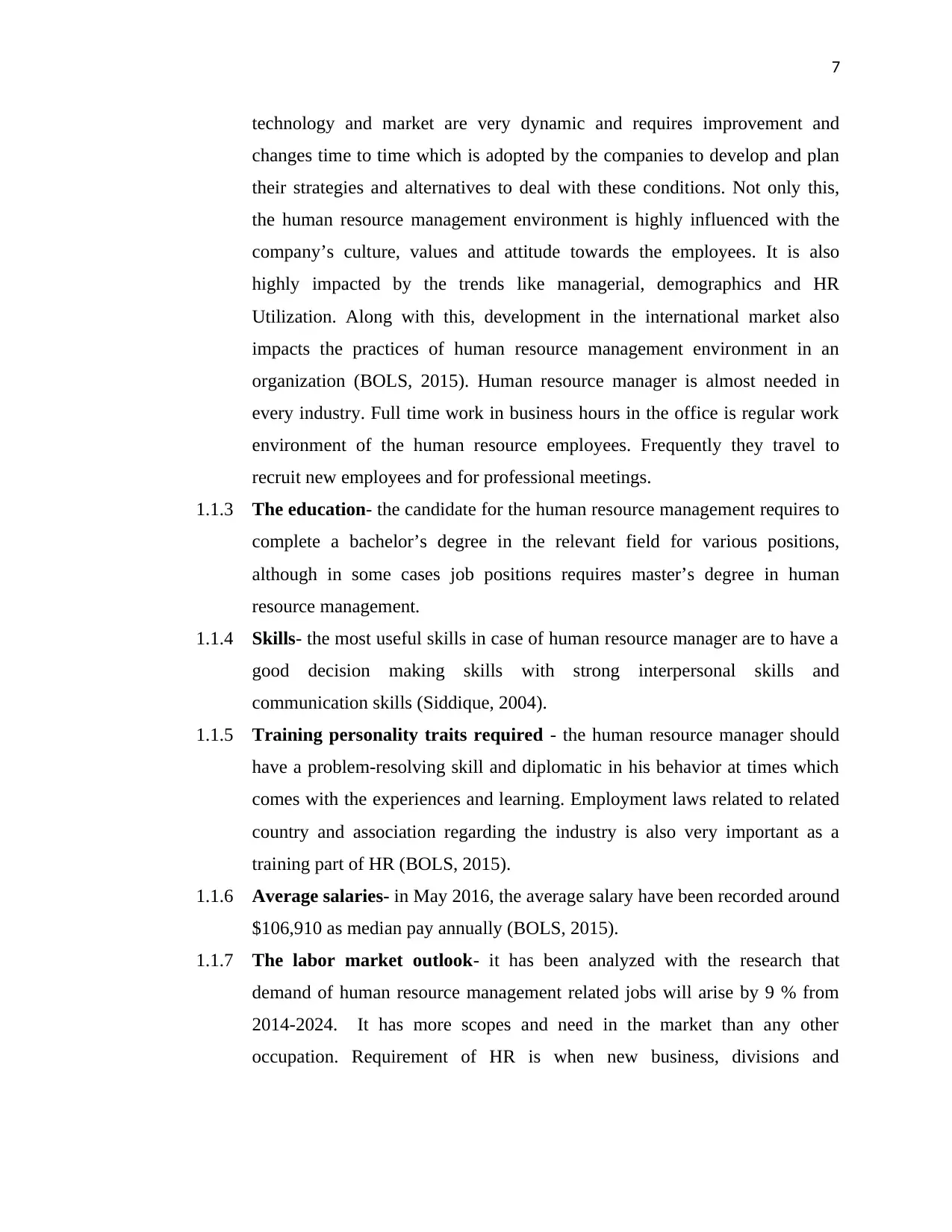
7
technology and market are very dynamic and requires improvement and
changes time to time which is adopted by the companies to develop and plan
their strategies and alternatives to deal with these conditions. Not only this,
the human resource management environment is highly influenced with the
company’s culture, values and attitude towards the employees. It is also
highly impacted by the trends like managerial, demographics and HR
Utilization. Along with this, development in the international market also
impacts the practices of human resource management environment in an
organization (BOLS, 2015). Human resource manager is almost needed in
every industry. Full time work in business hours in the office is regular work
environment of the human resource employees. Frequently they travel to
recruit new employees and for professional meetings.
1.1.3 The education- the candidate for the human resource management requires to
complete a bachelor’s degree in the relevant field for various positions,
although in some cases job positions requires master’s degree in human
resource management.
1.1.4 Skills- the most useful skills in case of human resource manager are to have a
good decision making skills with strong interpersonal skills and
communication skills (Siddique, 2004).
1.1.5 Training personality traits required - the human resource manager should
have a problem-resolving skill and diplomatic in his behavior at times which
comes with the experiences and learning. Employment laws related to related
country and association regarding the industry is also very important as a
training part of HR (BOLS, 2015).
1.1.6 Average salaries- in May 2016, the average salary have been recorded around
$106,910 as median pay annually (BOLS, 2015).
1.1.7 The labor market outlook- it has been analyzed with the research that
demand of human resource management related jobs will arise by 9 % from
2014-2024. It has more scopes and need in the market than any other
occupation. Requirement of HR is when new business, divisions and
technology and market are very dynamic and requires improvement and
changes time to time which is adopted by the companies to develop and plan
their strategies and alternatives to deal with these conditions. Not only this,
the human resource management environment is highly influenced with the
company’s culture, values and attitude towards the employees. It is also
highly impacted by the trends like managerial, demographics and HR
Utilization. Along with this, development in the international market also
impacts the practices of human resource management environment in an
organization (BOLS, 2015). Human resource manager is almost needed in
every industry. Full time work in business hours in the office is regular work
environment of the human resource employees. Frequently they travel to
recruit new employees and for professional meetings.
1.1.3 The education- the candidate for the human resource management requires to
complete a bachelor’s degree in the relevant field for various positions,
although in some cases job positions requires master’s degree in human
resource management.
1.1.4 Skills- the most useful skills in case of human resource manager are to have a
good decision making skills with strong interpersonal skills and
communication skills (Siddique, 2004).
1.1.5 Training personality traits required - the human resource manager should
have a problem-resolving skill and diplomatic in his behavior at times which
comes with the experiences and learning. Employment laws related to related
country and association regarding the industry is also very important as a
training part of HR (BOLS, 2015).
1.1.6 Average salaries- in May 2016, the average salary have been recorded around
$106,910 as median pay annually (BOLS, 2015).
1.1.7 The labor market outlook- it has been analyzed with the research that
demand of human resource management related jobs will arise by 9 % from
2014-2024. It has more scopes and need in the market than any other
occupation. Requirement of HR is when new business, divisions and
Paraphrase This Document
Need a fresh take? Get an instant paraphrase of this document with our AI Paraphraser
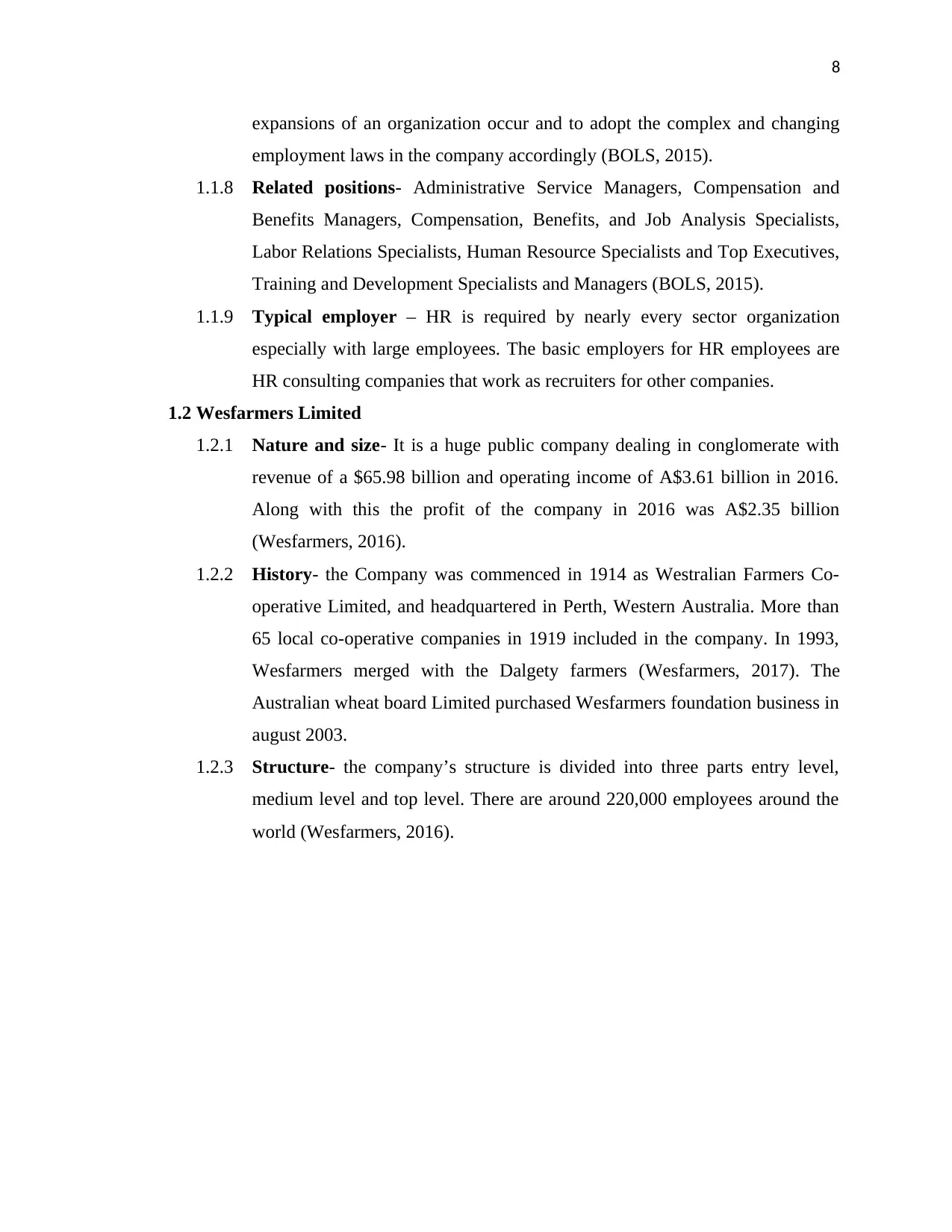
8
expansions of an organization occur and to adopt the complex and changing
employment laws in the company accordingly (BOLS, 2015).
1.1.8 Related positions- Administrative Service Managers, Compensation and
Benefits Managers, Compensation, Benefits, and Job Analysis Specialists,
Labor Relations Specialists, Human Resource Specialists and Top Executives,
Training and Development Specialists and Managers (BOLS, 2015).
1.1.9 Typical employer – HR is required by nearly every sector organization
especially with large employees. The basic employers for HR employees are
HR consulting companies that work as recruiters for other companies.
1.2 Wesfarmers Limited
1.2.1 Nature and size- It is a huge public company dealing in conglomerate with
revenue of a $65.98 billion and operating income of A$3.61 billion in 2016.
Along with this the profit of the company in 2016 was A$2.35 billion
(Wesfarmers, 2016).
1.2.2 History- the Company was commenced in 1914 as Westralian Farmers Co-
operative Limited, and headquartered in Perth, Western Australia. More than
65 local co-operative companies in 1919 included in the company. In 1993,
Wesfarmers merged with the Dalgety farmers (Wesfarmers, 2017). The
Australian wheat board Limited purchased Wesfarmers foundation business in
august 2003.
1.2.3 Structure- the company’s structure is divided into three parts entry level,
medium level and top level. There are around 220,000 employees around the
world (Wesfarmers, 2016).
expansions of an organization occur and to adopt the complex and changing
employment laws in the company accordingly (BOLS, 2015).
1.1.8 Related positions- Administrative Service Managers, Compensation and
Benefits Managers, Compensation, Benefits, and Job Analysis Specialists,
Labor Relations Specialists, Human Resource Specialists and Top Executives,
Training and Development Specialists and Managers (BOLS, 2015).
1.1.9 Typical employer – HR is required by nearly every sector organization
especially with large employees. The basic employers for HR employees are
HR consulting companies that work as recruiters for other companies.
1.2 Wesfarmers Limited
1.2.1 Nature and size- It is a huge public company dealing in conglomerate with
revenue of a $65.98 billion and operating income of A$3.61 billion in 2016.
Along with this the profit of the company in 2016 was A$2.35 billion
(Wesfarmers, 2016).
1.2.2 History- the Company was commenced in 1914 as Westralian Farmers Co-
operative Limited, and headquartered in Perth, Western Australia. More than
65 local co-operative companies in 1919 included in the company. In 1993,
Wesfarmers merged with the Dalgety farmers (Wesfarmers, 2017). The
Australian wheat board Limited purchased Wesfarmers foundation business in
august 2003.
1.2.3 Structure- the company’s structure is divided into three parts entry level,
medium level and top level. There are around 220,000 employees around the
world (Wesfarmers, 2016).
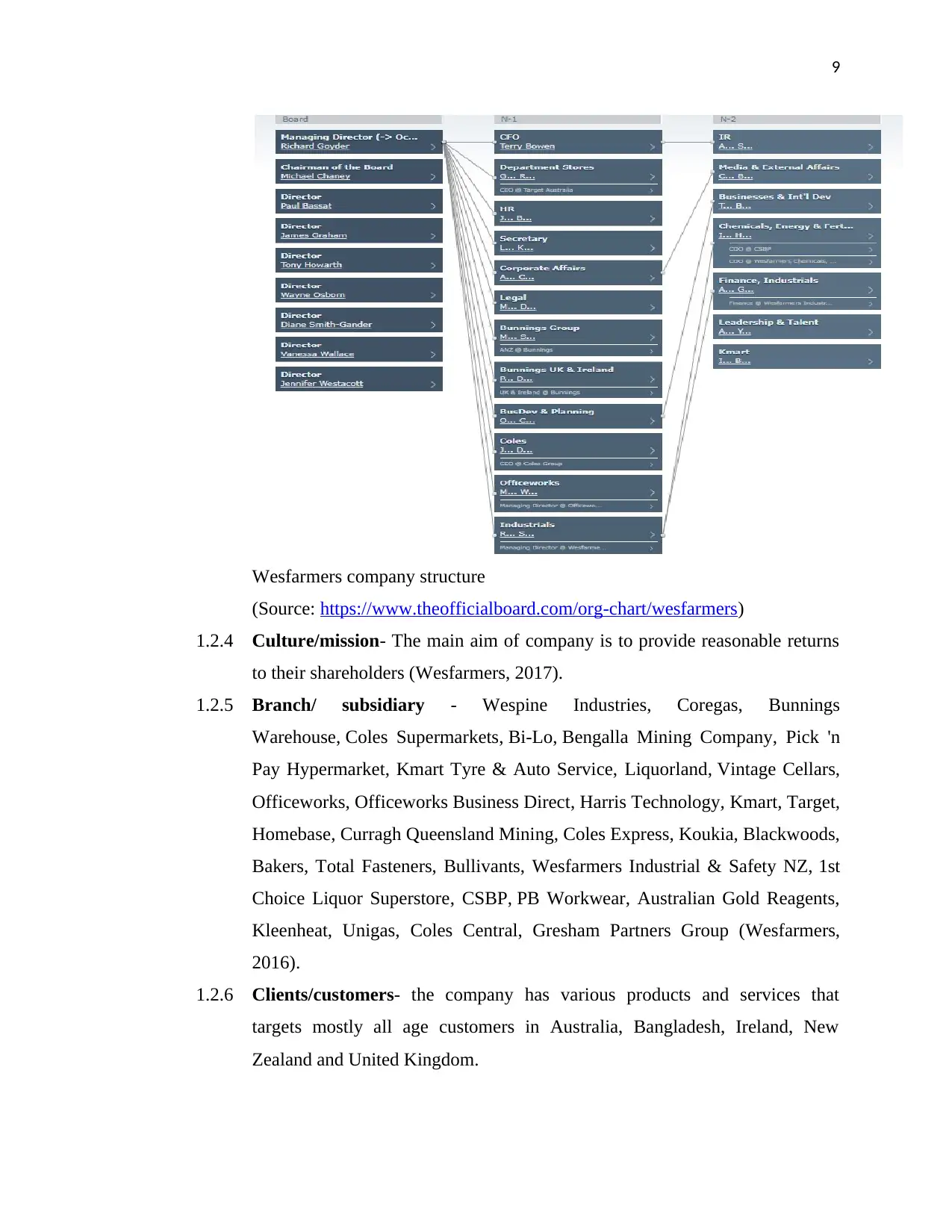
9
Wesfarmers company structure
(Source: https://www.theofficialboard.com/org-chart/wesfarmers)
1.2.4 Culture/mission- The main aim of company is to provide reasonable returns
to their shareholders (Wesfarmers, 2017).
1.2.5 Branch/ subsidiary - Wespine Industries, Coregas, Bunnings
Warehouse, Coles Supermarkets, Bi-Lo, Bengalla Mining Company, Pick 'n
Pay Hypermarket, Kmart Tyre & Auto Service, Liquorland, Vintage Cellars,
Officeworks, Officeworks Business Direct, Harris Technology, Kmart, Target,
Homebase, Curragh Queensland Mining, Coles Express, Koukia, Blackwoods,
Bakers, Total Fasteners, Bullivants, Wesfarmers Industrial & Safety NZ, 1st
Choice Liquor Superstore, CSBP, PB Workwear, Australian Gold Reagents,
Kleenheat, Unigas, Coles Central, Gresham Partners Group (Wesfarmers,
2016).
1.2.6 Clients/customers- the company has various products and services that
targets mostly all age customers in Australia, Bangladesh, Ireland, New
Zealand and United Kingdom.
Wesfarmers company structure
(Source: https://www.theofficialboard.com/org-chart/wesfarmers)
1.2.4 Culture/mission- The main aim of company is to provide reasonable returns
to their shareholders (Wesfarmers, 2017).
1.2.5 Branch/ subsidiary - Wespine Industries, Coregas, Bunnings
Warehouse, Coles Supermarkets, Bi-Lo, Bengalla Mining Company, Pick 'n
Pay Hypermarket, Kmart Tyre & Auto Service, Liquorland, Vintage Cellars,
Officeworks, Officeworks Business Direct, Harris Technology, Kmart, Target,
Homebase, Curragh Queensland Mining, Coles Express, Koukia, Blackwoods,
Bakers, Total Fasteners, Bullivants, Wesfarmers Industrial & Safety NZ, 1st
Choice Liquor Superstore, CSBP, PB Workwear, Australian Gold Reagents,
Kleenheat, Unigas, Coles Central, Gresham Partners Group (Wesfarmers,
2016).
1.2.6 Clients/customers- the company has various products and services that
targets mostly all age customers in Australia, Bangladesh, Ireland, New
Zealand and United Kingdom.
⊘ This is a preview!⊘
Do you want full access?
Subscribe today to unlock all pages.

Trusted by 1+ million students worldwide
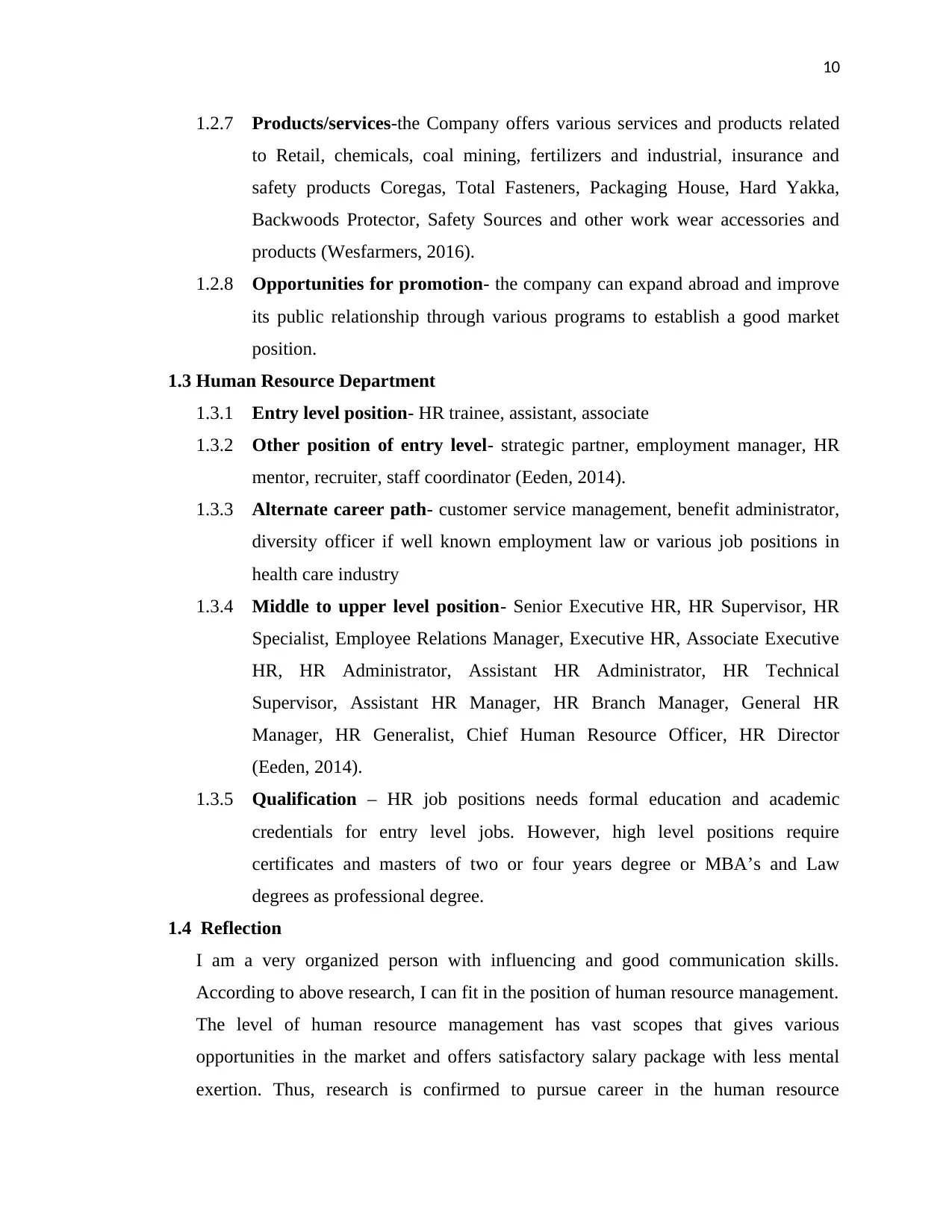
10
1.2.7 Products/services-the Company offers various services and products related
to Retail, chemicals, coal mining, fertilizers and industrial, insurance and
safety products Coregas, Total Fasteners, Packaging House, Hard Yakka,
Backwoods Protector, Safety Sources and other work wear accessories and
products (Wesfarmers, 2016).
1.2.8 Opportunities for promotion- the company can expand abroad and improve
its public relationship through various programs to establish a good market
position.
1.3 Human Resource Department
1.3.1 Entry level position- HR trainee, assistant, associate
1.3.2 Other position of entry level- strategic partner, employment manager, HR
mentor, recruiter, staff coordinator (Eeden, 2014).
1.3.3 Alternate career path- customer service management, benefit administrator,
diversity officer if well known employment law or various job positions in
health care industry
1.3.4 Middle to upper level position- Senior Executive HR, HR Supervisor, HR
Specialist, Employee Relations Manager, Executive HR, Associate Executive
HR, HR Administrator, Assistant HR Administrator, HR Technical
Supervisor, Assistant HR Manager, HR Branch Manager, General HR
Manager, HR Generalist, Chief Human Resource Officer, HR Director
(Eeden, 2014).
1.3.5 Qualification – HR job positions needs formal education and academic
credentials for entry level jobs. However, high level positions require
certificates and masters of two or four years degree or MBA’s and Law
degrees as professional degree.
1.4 Reflection
I am a very organized person with influencing and good communication skills.
According to above research, I can fit in the position of human resource management.
The level of human resource management has vast scopes that gives various
opportunities in the market and offers satisfactory salary package with less mental
exertion. Thus, research is confirmed to pursue career in the human resource
1.2.7 Products/services-the Company offers various services and products related
to Retail, chemicals, coal mining, fertilizers and industrial, insurance and
safety products Coregas, Total Fasteners, Packaging House, Hard Yakka,
Backwoods Protector, Safety Sources and other work wear accessories and
products (Wesfarmers, 2016).
1.2.8 Opportunities for promotion- the company can expand abroad and improve
its public relationship through various programs to establish a good market
position.
1.3 Human Resource Department
1.3.1 Entry level position- HR trainee, assistant, associate
1.3.2 Other position of entry level- strategic partner, employment manager, HR
mentor, recruiter, staff coordinator (Eeden, 2014).
1.3.3 Alternate career path- customer service management, benefit administrator,
diversity officer if well known employment law or various job positions in
health care industry
1.3.4 Middle to upper level position- Senior Executive HR, HR Supervisor, HR
Specialist, Employee Relations Manager, Executive HR, Associate Executive
HR, HR Administrator, Assistant HR Administrator, HR Technical
Supervisor, Assistant HR Manager, HR Branch Manager, General HR
Manager, HR Generalist, Chief Human Resource Officer, HR Director
(Eeden, 2014).
1.3.5 Qualification – HR job positions needs formal education and academic
credentials for entry level jobs. However, high level positions require
certificates and masters of two or four years degree or MBA’s and Law
degrees as professional degree.
1.4 Reflection
I am a very organized person with influencing and good communication skills.
According to above research, I can fit in the position of human resource management.
The level of human resource management has vast scopes that gives various
opportunities in the market and offers satisfactory salary package with less mental
exertion. Thus, research is confirmed to pursue career in the human resource
Paraphrase This Document
Need a fresh take? Get an instant paraphrase of this document with our AI Paraphraser
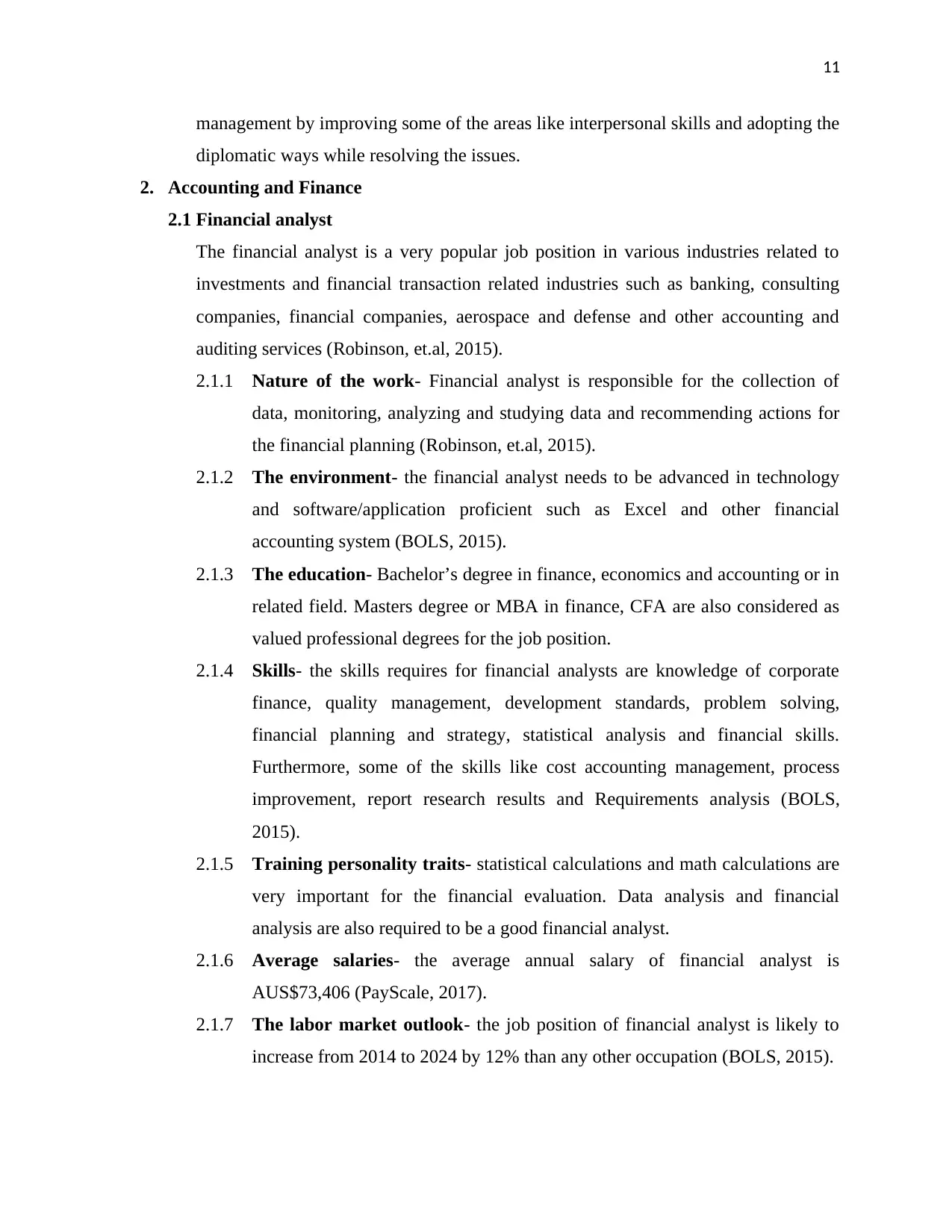
11
management by improving some of the areas like interpersonal skills and adopting the
diplomatic ways while resolving the issues.
2. Accounting and Finance
2.1 Financial analyst
The financial analyst is a very popular job position in various industries related to
investments and financial transaction related industries such as banking, consulting
companies, financial companies, aerospace and defense and other accounting and
auditing services (Robinson, et.al, 2015).
2.1.1 Nature of the work- Financial analyst is responsible for the collection of
data, monitoring, analyzing and studying data and recommending actions for
the financial planning (Robinson, et.al, 2015).
2.1.2 The environment- the financial analyst needs to be advanced in technology
and software/application proficient such as Excel and other financial
accounting system (BOLS, 2015).
2.1.3 The education- Bachelor’s degree in finance, economics and accounting or in
related field. Masters degree or MBA in finance, CFA are also considered as
valued professional degrees for the job position.
2.1.4 Skills- the skills requires for financial analysts are knowledge of corporate
finance, quality management, development standards, problem solving,
financial planning and strategy, statistical analysis and financial skills.
Furthermore, some of the skills like cost accounting management, process
improvement, report research results and Requirements analysis (BOLS,
2015).
2.1.5 Training personality traits- statistical calculations and math calculations are
very important for the financial evaluation. Data analysis and financial
analysis are also required to be a good financial analyst.
2.1.6 Average salaries- the average annual salary of financial analyst is
AUS$73,406 (PayScale, 2017).
2.1.7 The labor market outlook- the job position of financial analyst is likely to
increase from 2014 to 2024 by 12% than any other occupation (BOLS, 2015).
management by improving some of the areas like interpersonal skills and adopting the
diplomatic ways while resolving the issues.
2. Accounting and Finance
2.1 Financial analyst
The financial analyst is a very popular job position in various industries related to
investments and financial transaction related industries such as banking, consulting
companies, financial companies, aerospace and defense and other accounting and
auditing services (Robinson, et.al, 2015).
2.1.1 Nature of the work- Financial analyst is responsible for the collection of
data, monitoring, analyzing and studying data and recommending actions for
the financial planning (Robinson, et.al, 2015).
2.1.2 The environment- the financial analyst needs to be advanced in technology
and software/application proficient such as Excel and other financial
accounting system (BOLS, 2015).
2.1.3 The education- Bachelor’s degree in finance, economics and accounting or in
related field. Masters degree or MBA in finance, CFA are also considered as
valued professional degrees for the job position.
2.1.4 Skills- the skills requires for financial analysts are knowledge of corporate
finance, quality management, development standards, problem solving,
financial planning and strategy, statistical analysis and financial skills.
Furthermore, some of the skills like cost accounting management, process
improvement, report research results and Requirements analysis (BOLS,
2015).
2.1.5 Training personality traits- statistical calculations and math calculations are
very important for the financial evaluation. Data analysis and financial
analysis are also required to be a good financial analyst.
2.1.6 Average salaries- the average annual salary of financial analyst is
AUS$73,406 (PayScale, 2017).
2.1.7 The labor market outlook- the job position of financial analyst is likely to
increase from 2014 to 2024 by 12% than any other occupation (BOLS, 2015).
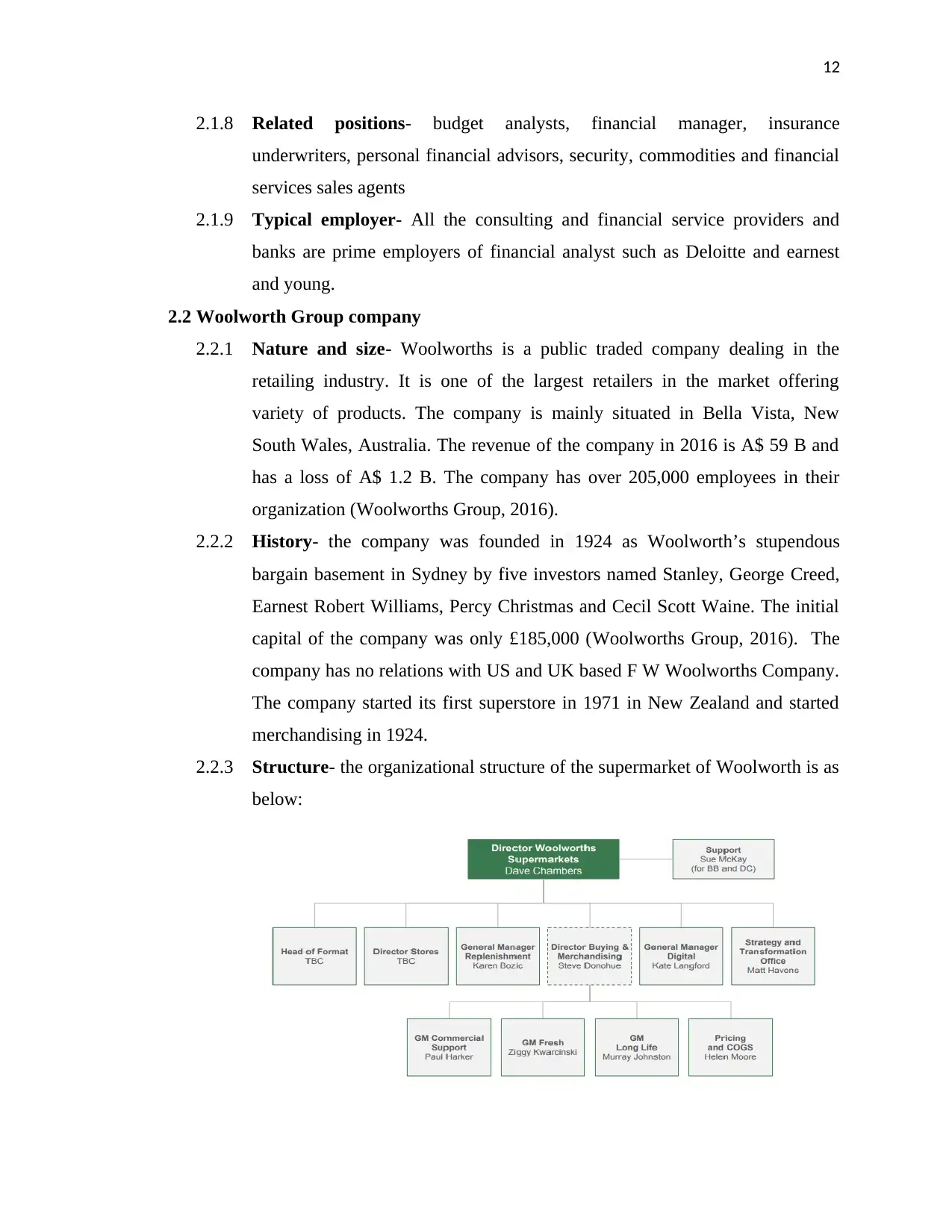
12
2.1.8 Related positions- budget analysts, financial manager, insurance
underwriters, personal financial advisors, security, commodities and financial
services sales agents
2.1.9 Typical employer- All the consulting and financial service providers and
banks are prime employers of financial analyst such as Deloitte and earnest
and young.
2.2 Woolworth Group company
2.2.1 Nature and size- Woolworths is a public traded company dealing in the
retailing industry. It is one of the largest retailers in the market offering
variety of products. The company is mainly situated in Bella Vista, New
South Wales, Australia. The revenue of the company in 2016 is A$ 59 B and
has a loss of A$ 1.2 B. The company has over 205,000 employees in their
organization (Woolworths Group, 2016).
2.2.2 History- the company was founded in 1924 as Woolworth’s stupendous
bargain basement in Sydney by five investors named Stanley, George Creed,
Earnest Robert Williams, Percy Christmas and Cecil Scott Waine. The initial
capital of the company was only £185,000 (Woolworths Group, 2016). The
company has no relations with US and UK based F W Woolworths Company.
The company started its first superstore in 1971 in New Zealand and started
merchandising in 1924.
2.2.3 Structure- the organizational structure of the supermarket of Woolworth is as
below:
2.1.8 Related positions- budget analysts, financial manager, insurance
underwriters, personal financial advisors, security, commodities and financial
services sales agents
2.1.9 Typical employer- All the consulting and financial service providers and
banks are prime employers of financial analyst such as Deloitte and earnest
and young.
2.2 Woolworth Group company
2.2.1 Nature and size- Woolworths is a public traded company dealing in the
retailing industry. It is one of the largest retailers in the market offering
variety of products. The company is mainly situated in Bella Vista, New
South Wales, Australia. The revenue of the company in 2016 is A$ 59 B and
has a loss of A$ 1.2 B. The company has over 205,000 employees in their
organization (Woolworths Group, 2016).
2.2.2 History- the company was founded in 1924 as Woolworth’s stupendous
bargain basement in Sydney by five investors named Stanley, George Creed,
Earnest Robert Williams, Percy Christmas and Cecil Scott Waine. The initial
capital of the company was only £185,000 (Woolworths Group, 2016). The
company has no relations with US and UK based F W Woolworths Company.
The company started its first superstore in 1971 in New Zealand and started
merchandising in 1924.
2.2.3 Structure- the organizational structure of the supermarket of Woolworth is as
below:
⊘ This is a preview!⊘
Do you want full access?
Subscribe today to unlock all pages.

Trusted by 1+ million students worldwide
1 out of 19
Related Documents
Your All-in-One AI-Powered Toolkit for Academic Success.
+13062052269
info@desklib.com
Available 24*7 on WhatsApp / Email
![[object Object]](/_next/static/media/star-bottom.7253800d.svg)
Unlock your academic potential
Copyright © 2020–2025 A2Z Services. All Rights Reserved. Developed and managed by ZUCOL.




